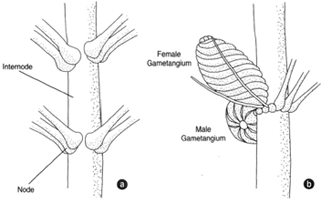Green Alga or Bryophyta?
There remains a presumed green alga different enough from all others that some algologists place it in a separate class. While it is generally believed to belong with green algae, a few would classify it as Bryophyta. It is an ancient form, tracing its beginnings to Silurian timeThe representative form is Chara. The cell walls contain cellulose and are also much impregnated with lime. Chara is a submerged, bottom-dweller of clear water. It possesses whorls of branches and both vertical and horizontal stems, and is anchored by rhizoids. Single, large cells extend from one set of branches to the next and may have several nuclei. Growth occurs from apical cells, as it does in higher plants. The apical cells divide by mitosis, and several kinds of cells including oogonia and antheridia are differentiated further down the stem. A singular feature of the Charophyceae is that the gametangia are surrounded by jackets of sterile cells.
 |
| Figure 13-11 Chara, a stonewort: (a) a portion of stem showing nodes and internodes; (b) male and female gametangia |
Figure 13-11 shows gametangia borne on branches. The oogonium is surrounded by a jacket of elongated, curved cells. It contains a single egg. In maturity, the sheath cells separate near the tip to allow the entry of sperm. The antheridia are arranged in clustersa nd show a complex structure. Within the sheath of sterile cells, the sperm-producing cells occur in chains, and each cell forms a single, biflagellated sperm. When fertilization takes place, the zygote develops a thickened wall and remains in a resting state for several weeks. When growth is initiated, meiosis takes place within the oogonial wall. Three of the resulting nuclei degenerate, and the remaining nucleus produces a protonema, which then may grow to a new thallus.




